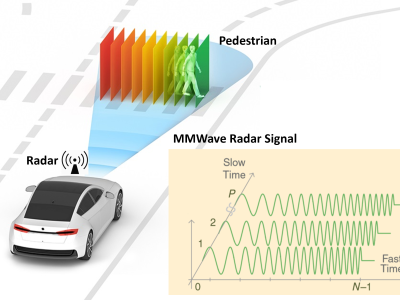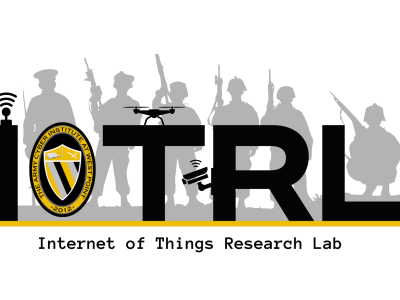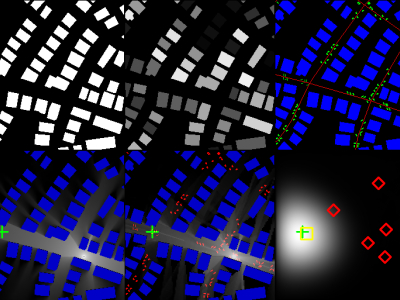CRAWDAD umass/long_distance

- Citation Author(s):
-
Timothy Ireland (University of Massachusetts)Adam Nyzio (University of Massachusetts)Michael Zink (University of Massachusetts)Jim Kurose (University of Massachusetts)
- Submitted by:
- CRAWDAD Team
- Last updated:
- DOI:
- 10.15783/C70K5D
- Data Format:
 118 views
118 views
- Categories:
Abstract
Our experiments consisted of 802.11g wireless network throughput measurements in various overlapping ad-hoc node configurations in order to better understand interference when using yagi antennas to extend the range of the wireless transmission.
last modified : 2008-06-05
release date : 2007-06-01
date/time of measurement start : 2006-10-10
date/time of measurement end : 2006-12-09
collection environment : With the increasing popularity of 802.11 wireless technology, such equipment has recently been used to set up long distance links for wireless mesh networks. To be able to increase the range of 802.11 equipment directional antennas are required. We measured the effects of wireless interference on throughput. Our experiments consisted of 802.11g wireless network throughput measurements in various overlapping ad-hoc node configurations in order to better understand interference when using yagi antennas to extend the range of the wireless transmission. We were particularly interested in the behavior at the multi-hop node, which has 2 antennas in close proximity as would be required on a communications tower.
network configuration : The test equipment consists of 4 Lenovo T60 notebooks running slackware Linux with the 2.6 kernel, and using ProximWLAN adapters (atheros chipset), and we are using the opensourceMadWifi drivers for the wireless cards. These PCMCIA cards are connected to an external Hyperlink Yagi antenna to extend their range. We make a special point to note that MadWifi driver includes a proprietary HAL that controls many key aspects of the adapters, one of which being the use of measured RSSI values to sense whether the channel is in use, contrasted with the RTS/CTS scheme that other wireless cards use to sense the channel. We suspect that this channel contention scheme leads to some unexpected behavior in our ad-hoc test network.
data collection methodology : We used Iperf3, a tool to measure maximum TCP bandwidth, to investigate how the different setups would change the overall performance of the multi-hop link. Additional tcpdump4 traces were taken in order to obtain more detailed information on a per-packet level. Each measurement ran for 30 seconds and was repeated 10 times. We decided to repeat each measurement 10 times to average out the effects of any short-term artifacts on the wireless channel. For each test we vary the channels 1-6 on pair2 while keeping pair1 on channel 1. It should be noted that we tested overlap up to 5 channels of separation because after that there is such minimal overlap in the spectrum, that the results would not vary.
Traceset
umass/long_distance/interference
Traceset of 802.11g long-distance measurements over ad-hoc nodes using directional antennas.
- description: Our experiments consisted of 802.11g wireless network throughput measurements in various overlapping ad-hoc node configurations in order to better understand interference when using yagi antennas to extend the range of the wireless transmission.
- measurement purpose: Network Performance Analysis, Routing Protocol
- methodology: Our experiments consisted of 802.11g wireless network throughput measurements in various overlapping ad-hoc node configurations in order to better understand interference when using yagi antennas to extend the range of the wireless transmission. A. Node Location and Spatial Separation As shown in [Figure: Measurement setup], Node 4 was set up in 3 different locations while Node 1 and the multi-hop node (composed of Nodes 2 and 3) stayed in fixed locations. In the multi-hop node the only change that was made for the different setups was the orientation of Node 3's antenna to line it up with Node 4's antenna. For all measurements except one the two antennas at the multi-hop node were placed 4 feet from each other in the horizontal plane, with no separation in the vertical plane. In the setup for the final measurement we also separated the two antennas at the middle node by 4 feet in the vertical plane. We assumed that a distance of 4 feet would be a separation distance typical of installations on communication towers. Five different setups, which are explained in more detail in the following, were used for the throughput measurements. In setup 1, all nodes are located along a virtual line. The two antennas at the multi-hop node are mounted in a way that they point directly away (180 ) from each other. In setup 2, link 2 is shifted by 45, resulting in a 135 angle between the main lobes of the two antennas at the multi-hop node. Link 2 is shifted by 90 in setup 3, which also results in a 90 separation of the antennas. Setup 4 is identical to setup 3 with the difference that the polarization of the antennas of link 2 is changed from horizontal to vertical. This is achieved by rotating the mounting of the Yagi antennas by 90 in the horizontal plane. Setup 5 is identical to setup 1 with the difference that the antennas were not only separated by 4 feet in the horizontal but also by 4 feet in the vertical plane. B. Transport Scenario We performed measurements where data was transmitted in two different ways. - N4 -> N3 | N2 -> N1: Here, N4 and N2 are sending data simultaneously to N3 and N1, respectively. - N4 -> N3 -> N2 -> N1: N4 is sending data all the way to N1 in this scenario. Thus, routing between N2 and N3 is enabled. We chose this specific routing configuration for several reasons. In the first scenario we want to investigate the interference that is caused at a multi-hop node with directional antennas when one radio is receiving while the other one is sending. In the second scenario, we were interested in studying the effects of concurrent forwarding on the N1-N2 and N3-N4 links, as well as the effects of routing on the wired link 3 in the multi-hop node. The second case is interesting since in many cases data will be routed through the multi-hop node between the two end nodes. For example, in the case where such a multi-hop node is used to allow data transmission from a remote sensor network. Here, the multi-hop node is neither a source nor a sink. The first case reflects a scenario in which the multi-hop node also acts as a source or a sink. C. Baseline Measurements We performed two preliminary measurements in a single link setup to measure the maximum throughput on that link without any interference from the other link. The first measurement was executed in the same open field where all multi-link measurements were performed. We ran an Iperf measurement on one link only, while the other one was idle, which resulted in 27 Mbps of average throughput. This throughput value is the upper limit for the multi-hop measurements. In the second setup we were interested how the throughput would change on a much longer link. Therefore, we set up a link of approximately 1 Mile in hilly terrain. Here, the Iperf measurement resulted in an average throughput of 25.54 Mbps.
umass/long_distance/interference Traces
- test1: Trace of 802.11g long-distance measurements using directional antennas.
- configuration: In each of 13 tests, nodes 1 and 2 are on essid pair1, and nodes 3 and 4 are on essid pair2, this allows us to force the traffic to be routed through the multi-hop node instead of the overlap just reaching the far reciever in some cases. For each of 5 network configurations, we conducted 2 experiments; we tested througput in a 2-hop routing configuration (where we consider the middle node as a virutal single node), and we tested throughput in a non-routing configuration where 2 nodes, one from each essid, are sending at the same time. In the non-routing test the multi-hop node is sending on one interface and recieving on the other. Test 1: N4 -> N3 | N2 -> N1 In this test we look at the interference when two nodes are sending towards a multi-hop node and the multi-hop node is recieving on both interfaces. The nodes are in a straight line, 180 degree. Nodes 1 and 4 transmit at the same time towards the center node. We see a steady increase in throughput as we extend the channel seperation. The signal strength did not match the throughput results exactely, it increased at a separation of 2 and 3, and dropped down to 20-30 RSSI for the remainder.:
- test2: Trace of 802.11g long-distance measurements using directional antennas.
- configuration: In each of 13 tests, nodes 1 and 2 are on essid pair1, and nodes 3 and 4 are on essid pair2, this allows us to force the traffic to be routed through the multi-hop node instead of the overlap just reaching the far reciever in some cases. For each of 5 network configurations, we conducted 2 experiments; we tested througput in a 2-hop routing configuration (where we consider the middle node as a virutal single node), and we tested throughput in a non-routing configuration where 2 nodes, one from each essid, are sending at the same time. In the non-routing test the multi-hop node is sending on one interface and recieving on the other. Test 2: N4 -> N3 | N2 -> N1 In this test we look into interference when two nodes transmit at the same time. Nodes 2 and 4 transmit at the same time and the multi-hop node is sending on one interface and recieving on the other. The antennas at the center node are separated by 5 minutes. The nodes are in a straight line, 180 degree. We noticed that there was a lot of variance in the throughput on this test, and we suspect that this may be due to the way that the wireless interfaces contend for the channel. Another reason for the variance could be that node 4 is overshooting the multi-hop node and is being sensed at node 1 as node1 is recieving from node2. The throughput is consistently higher on the pair2 network which seems to support this idea. Also, on channel 4 pair2 had throughput upwards of 24 Mbps, but all of a sudden around run 7 of 10 it seemed to lose the channel and pair1 started to take over. This is why there is such a large variation at a channel seperation of 3.
- test3: Trace of 802.11g long-distance measurements using directional antennas.
- configuration: In each of 13 tests, nodes 1 and 2 are on essid pair1, and nodes 3 and 4 are on essid pair2, this allows us to force the traffic to be routed through the multi-hop node instead of the overlap just reaching the far reciever in some cases. For each of 5 network configurations, we conducted 2 experiments; we tested througput in a 2-hop routing configuration (where we consider the middle node as a virutal single node), and we tested throughput in a non-routing configuration where 2 nodes, one from each essid, are sending at the same time. In the non-routing test the multi-hop node is sending on one interface and recieving on the other. Test 3: N4 -> N3 -> N2 -> N1 In this test we have configured the multi-hop node as a gateway for each end node, and so node 4 is running the iperf client, and node 1 is running the iperf server. The nodes are in a straight line, 180 degree. And the two nodes at the center are spaced about 5 minutes apart. We experienced a throughput of 4.3 Mbps on channel 1, poor in comparison, but as the channels separate the throughput steadily grows to 27 Mbps
- test4: Trace of 802.11g long-distance measurements using directional antennas.
- configuration: In each of 13 tests, nodes 1 and 2 are on essid pair1, and nodes 3 and 4 are on essid pair2, this allows us to force the traffic to be routed through the multi-hop node instead of the overlap just reaching the far reciever in some cases. For each of 5 network configurations, we conducted 2 experiments; we tested througput in a 2-hop routing configuration (where we consider the middle node as a virutal single node), and we tested throughput in a non-routing configuration where 2 nodes, one from each essid, are sending at the same time. In the non-routing test the multi-hop node is sending on one interface and recieving on the other. Test 4: N4 -> N3 | N2 -> N1 In this configuration we create a 135 degree angle between nodes 3 and 4 by rotating node 4 by 45 degree. No routing is used in this test and nodes 4 and 2 transmit at the same time. The antenna's at the center are spaces 5 minutes apart. The performace is slightly better, definately more consistent at this angle, rather than directly facing each other yet it is worse on channel 2. Overall this angle is much better than the 90 degree setup which had 5 Mbps on channel 1.
- test5: Trace of 802.11g long-distance measurements using directional antennas.
- configuration: In each of 13 tests, nodes 1 and 2 are on essid pair1, and nodes 3 and 4 are on essid pair2, this allows us to force the traffic to be routed through the multi-hop node instead of the overlap just reaching the far reciever in some cases. For each of 5 network configurations, we conducted 2 experiments; we tested througput in a 2-hop routing configuration (where we consider the middle node as a virutal single node), and we tested throughput in a non-routing configuration where 2 nodes, one from each essid, are sending at the same time. In the non-routing test the multi-hop node is sending on one interface and recieving on the other. Test 5: N4 -> N3 -> N2 -> N1 This setup is a 135 degree test similar to test 4, except that we have enabled routing via the multi-hop node. The antenna's at the center are about 5 minutes apart. The iperf server is run on node 1 and node 4 is the client. At this antenna orientation we have much better performance that in the 180 degree case, 13 Mbps vs. 4 Mpbs on channel 1. We think that this is due to the fact that the antenna pattern of the yagi's has a weak spot right at the 135 degree section (off center), and so we are not causing as much interference with the sender at the multi-hop node (node 2).
- test6: Trace of 802.11g long-distance measurements using directional antennas.
- configuration: In each of 13 tests, nodes 1 and 2 are on essid pair1, and nodes 3 and 4 are on essid pair2, this allows us to force the traffic to be routed through the multi-hop node instead of the overlap just reaching the far reciever in some cases. For each of 5 network configurations, we conducted 2 experiments; we tested througput in a 2-hop routing configuration (where we consider the middle node as a virutal single node), and we tested throughput in a non-routing configuration where 2 nodes, one from each essid, are sending at the same time. In the non-routing test the multi-hop node is sending on one interface and recieving on the other. Test 6: N4 -> N3 | N2 -> N1 In this test we alter the antenna orientation to 90 degree off center, between node 3 and 4. The antenna's at the center are 5 minutes apart. Again, both nodes are transmitting simultanously. Pair 1 seems to dominate the channels this time, and has much higher throughput (25 Mbps for pair1 vs. 5 Mbps for pair2). The sidelobes of the antenna are largest at 90 degree so this could account for the poor performance on pair2. It seems thought that in the scenario's where there are 2 simultaneous transmissions and no routing, that one side seems to dominate.
- test7: Trace of 802.11g long-distance measurements using directional antennas.
- configuration: In each of 13 tests, nodes 1 and 2 are on essid pair1, and nodes 3 and 4 are on essid pair2, this allows us to force the traffic to be routed through the multi-hop node instead of the overlap just reaching the far reciever in some cases. For each of 5 network configurations, we conducted 2 experiments; we tested througput in a 2-hop routing configuration (where we consider the middle node as a virutal single node), and we tested throughput in a non-routing configuration where 2 nodes, one from each essid, are sending at the same time. In the non-routing test the multi-hop node is sending on one interface and recieving on the other. Test 7: N4 -> N3 -> N2 -> N1 This is a routing test which was conducted with a 90 degree antenna orientation between nodes 3 and 4. The antenna's at the center are 5 minutes apart. Routing is enabled this time, with node 4 as the iperf client and node 1 as the server. The throughput here was a little worse than the 135 degree case, 10 Mbps here vs. 14 Mbps at 135 degree, yet much better than the 180 degree case which had a throughput of 3.5 on channel 1. We believe that the better results at low channel separations is due to orientation angle, and also in that when routing is enabled, the networks negotiate the channel better and share the bandwidth more evenly even with the side-lobe overlap.
- test8: Trace of 802.11g long-distance measurements using directional antennas.
- configuration: In each of 13 tests, nodes 1 and 2 are on essid pair1, and nodes 3 and 4 are on essid pair2, this allows us to force the traffic to be routed through the multi-hop node instead of the overlap just reaching the far reciever in some cases. For each of 5 network configurations, we conducted 2 experiments; we tested througput in a 2-hop routing configuration (where we consider the middle node as a virutal single node), and we tested throughput in a non-routing configuration where 2 nodes, one from each essid, are sending at the same time. In the non-routing test the multi-hop node is sending on one interface and recieving on the other. Test 8: N4 -> N3 | N2 -> N1 This test was conducted at a 90 degree orientation, and also the pair2 network has changed polarization of the yagi antennas from vertical to horizontal. The pair1 network is still at the vertical orientation. The antenna's at the multi-hop node are separated by 5 minutes. Both Nodes 2 and 4 transmit simultaneously. In this case the channel is shared a little better than in test 7 where the only difference was in the polarization. But here pair2 dominates the channels an has higher throughput, except on channel 1 they are both right at 15 Mbps. In test 7 on channel 1 both pairs were at a difference of 20 Mbps. This suggests that the polarization has a large effect when operating on the same channel.
- test9: Trace of 802.11g long-distance measurements using directional antennas.
- configuration: In each of 13 tests, nodes 1 and 2 are on essid pair1, and nodes 3 and 4 are on essid pair2, this allows us to force the traffic to be routed through the multi-hop node instead of the overlap just reaching the far reciever in some cases. For each of 5 network configurations, we conducted 2 experiments; we tested througput in a 2-hop routing configuration (where we consider the middle node as a virutal single node), and we tested throughput in a non-routing configuration where 2 nodes, one from each essid, are sending at the same time. In the non-routing test the multi-hop node is sending on one interface and recieving on the other. Test 9: N4 -> N3 -> N2 -> N1 This test was conducted at a 90 degree orientation with opposite polarizations on each network. Pair2 is set to horizontal polarization while pair1 is vertical. The antenna's at the multi-hop node are separated by 5 minutes. Node 4 transmits to Node 1 by routing through the multi-hop node. This result is very similar to the 135 degree test when routing is enabled. Routing in this case seems to make both networks share the bandwidth regardless of the polarization.
- test10: Trace of 802.11g long-distance measurements using directional antennas.
- configuration: In each of 13 tests, nodes 1 and 2 are on essid pair1, and nodes 3 and 4 are on essid pair2, this allows us to force the traffic to be routed through the multi-hop node instead of the overlap just reaching the far reciever in some cases. For each of 5 network configurations, we conducted 2 experiments; we tested througput in a 2-hop routing configuration (where we consider the middle node as a virutal single node), and we tested throughput in a non-routing configuration where 2 nodes, one from each essid, are sending at the same time. In the non-routing test the multi-hop node is sending on one interface and recieving on the other. Test 10: N4 -> N3 | N2 -> N1 This test was performed at 180 degree and both networks were set to the same vertical polarization. The Height of the antenna's was altered so that pair2 was at an elevation of 11 minutes and pair1 was at an elevation of 2 minutes. We wanted to see if this would have an effect on interference at the middle node. Nodes 2 and 4 transmitted simultaneously. The performance was a little bit worse than in test 3, the 180 degree case with no additional adjustments. This is most likely due to outside interference due to the fact that the field we were testing in became a parking lot for an event, and the influx of cars on this occasion cause unmeasureable effects on the results. We repeat this test again in test 12.
- test11: Trace of 802.11g long-distance measurements using directional antennas.
- configuration: In each of 13 tests, nodes 1 and 2 are on essid pair1, and nodes 3 and 4 are on essid pair2, this allows us to force the traffic to be routed through the multi-hop node instead of the overlap just reaching the far reciever in some cases. For each of 5 network configurations, we conducted 2 experiments; we tested througput in a 2-hop routing configuration (where we consider the middle node as a virutal single node), and we tested throughput in a non-routing configuration where 2 nodes, one from each essid, are sending at the same time. In the non-routing test the multi-hop node is sending on one interface and recieving on the other. Test 11: N4 -> N3 -> N2 -> N1 This test was performed at 180 degree and both networks were set to the same vertical polarization. The Height of the antenna's was altered so that pair2 was at an elevation of 11 minutes and pair1 was at an elevation of 2 minutes. We wanted to see if this would have an effect on interference at the middle node. Routing was enabled but performance was poor due to outside factors, the influx of cars on this occasion cause unmeasureable effects on the results. We repeat this test again in test 13.
- test12: Trace of 802.11g long-distance measurements using directional antennas.
- configuration: In each of 13 tests, nodes 1 and 2 are on essid pair1, and nodes 3 and 4 are on essid pair2, this allows us to force the traffic to be routed through the multi-hop node instead of the overlap just reaching the far reciever in some cases. For each of 5 network configurations, we conducted 2 experiments; we tested througput in a 2-hop routing configuration (where we consider the middle node as a virutal single node), and we tested throughput in a non-routing configuration where 2 nodes, one from each essid, are sending at the same time. In the non-routing test the multi-hop node is sending on one interface and recieving on the other. Test 12: N4 -> N3 | N2 -> N1 Simultaneous transmission height difference test - repeat of 10. Pair2 really dominated this time. The throughput on pair2 was much better than in test3, but pair1's thoughput was really poor. Again, channel contention algorithms have a big part in this phenomenon. Pair2 seems to have grabbed the bandwidth and stuck with it. Pair1's gains came during intervals of the 10 runs when pair2 stopped sending breifly to start another run.
- test13: Trace of 802.11g long-distance measurements using directional antennas.
- configuration: In each of 13 tests, nodes 1 and 2 are on essid pair1, and nodes 3 and 4 are on essid pair2, this allows us to force the traffic to be routed through the multi-hop node instead of the overlap just reaching the far reciever in some cases. For each of 5 network configurations, we conducted 2 experiments; we tested througput in a 2-hop routing configuration (where we consider the middle node as a virutal single node), and we tested throughput in a non-routing configuration where 2 nodes, one from each essid, are sending at the same time. In the non-routing test the multi-hop node is sending on one interface and recieving on the other. Test 13: N4 -> N3 -> N2 -> N1 Routing height separated test - repeat of 11. Here we actually do worse than in the 180 degree non-height separated routing scenario. We are not really sure why, we expected a benefit.
Instructions:
The files in this directory are a CRAWDAD dataset hosted by IEEE DataPort.
About CRAWDAD: the Community Resource for Archiving Wireless Data At Dartmouth is a data resource for the research community interested in wireless networks and mobile computing.
CRAWDAD was founded at Dartmouth College in 2004, led by Tristan Henderson, David Kotz, and Chris McDonald. CRAWDAD datasets are hosted by IEEE DataPort as of November 2022.
Note: Please use the Data in an ethical and responsible way with the aim of doing no harm to any person or entity for the benefit of society at large. Please respect the privacy of any human subjects whose wireless-network activity is captured by the Data and comply with all applicable laws, including without limitation such applicable laws pertaining to the protection of personal information, security of data, and data breaches. Please do not apply, adapt or develop algorithms for the extraction of the true identity of users and other information of a personal nature, which might constitute personally identifiable information or protected health information under any such applicable laws. Do not publish or otherwise disclose to any other person or entity any information that constitutes personally identifiable information or protected health information under any such applicable laws derived from the Data through manual or automated techniques.
Please acknowledge the source of the Data in any publications or presentations reporting use of this Data.
Citation:
Timothy Ireland, Adam Nyzio, Michael Zink, Jim Kurose, umass/long_distance, https://doi.org/10.15783/C70K5D , Date: 20070601
















